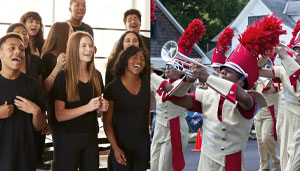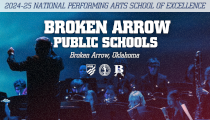How to Prevent a Rock Guitar Player from Ruining Your Jazz Band (Just Kidding?)
By Douglas Maher on January 13, 2020 music directors & adjudicators article PrintMany years ago, an esteemed and respected band director asked that I provide private lessons for his student guitarist. He was considering admitting this student into his jazz band, which would be a first in his 25-year teaching career. He wanted to make sure that having a guitarist would not “ruin” his jazz band. I was not sure if his comment was serious. But could this happen? The answer is yes, through no intended fault of the student or band director. There are several reasons, but the main ones are a lack of information about the electric guitar and its technique, sound, and function in the jazz band rhythm section. This article will attempt to provide information to help guitar players make a positive contribution to the jazz band and to the sanity and happiness of the band director.
Few if any other musical instruments have a history as long and varied as the guitar.
Plucked string instruments of a variety of shapes precede it, dating back to 3000 B.C. The plucked string instrument of various numbers of strings first called the guitar appeared in Spain around 1400. The modern guitar with 6 gut (now nylon) strings, as played by maestro Andres Segovia in the 20th century through modern day classical guitarists, was created in the 1800’s. By the early 1900’s the steel string acoustic guitar had crossed stylistic and social boundaries, as found in the country blues of Robert Johnson and the early bluegrass music of Maybelle Carter. The 20th century explosion of interest in the electric guitar, invented by Adolph Rickenbacher and advanced by Les Paul and Leo Fender, is found in virtually all styles of popular music, from the jazz guitar of Charlie Christian, electric blues of B.B. King, Rock and Roll of Chuck Berry, and all their guitar descendants of today. This rich and diverse history of guitar styles and techniques present a variety of challenges and choices for today’s guitar student. A lack of informed decisions by the student and band director can in fact have a negative impact on the school jazz band. I offer my commentary and recommendations to improve the performance of the electric guitar student.
Music Literacy
The contemporary guitarist performing blues, jazz, country, rock, and all of their subgenres does not need to be able to read music to be proficient and successful. There, I said it. This flies in the face of the goal of music literacy in music education - a goal which I wholeheartedly support. Yet how can we deny the success and impact of Jimi Hendrix, Sir Paul McCartney (who to this day cannot read music), Taylor Swift, etc.? Most guitar players who are first drawn to the “folk art” styles of music learn by ear, playing along with recordings or with other musicians. These young musicians are in my opinion usually more aurally advanced than their concert band peers.
Often during my career as a band director, I observed students who were “the rock guitar players” who were “looking through the window” at a concert band rehearsal, assuming there was no opportunity for them to participate. Some band directors have integrated guitar and keyboard into the concert band (i.e. “New Band” repertoire) but that’s another discussion. How can we coax “the rock guitar player” into the conventional concert band to experience all the musical benefits of reading notation, intonation, melody, harmony, rhythm, dynamics, timbre etc., and also learn about the commitment, responsibility and teamwork that band provides? With no disrespect to the art of the percussionist, I suggest to recruit that rock guitarist to play the bass drum or cymbals. If he or she is particularly motivated, offer a wind instrument - (Two of my guitar players eventually became quite skilled trombonists). Yes, this is extra work, but is beneficial for both students and the band program. I’ve heard the band director joke “how do you get a guitar player to turn it down? Put music in front of them”, yet in my opinion most teachers don’t acknowledge the difficulty of reading music on guitar combined with the lack of ensemble participation experience. Several of my most successful guitar students also played other instruments in the concert band. The growing popularity of Suzuki guitar is a positive advancement for guitar music literacy, but that’s like comparing apples to oranges for an electric guitar player.
The usual secondary school performance opportunity for the guitarist is the jazz band. The secondary school jazz band is (or should be) a musical experience that requires music literacy. The reality is that if the resources are available the band director needs to connect the young rock guitarist with a qualified jazz guitar private instructor who will stress music literacy. The following are guitar pedagogy suggestions:
Method Books
- The Hal Leonard Guitar Method, Complete Edition by Will Schmid and Greg Koch
This method provides an introduction to notation and melody reading, which utilizes the open strings of the guitar in the 1st position. This sound IS NOT ACCEPTABLE for reading melodies in a jazz band, but it’s a start. It also provides the 15 basic open chords (“the cowboy chords”) which are also NOT ACCEPTABLE for jazz band rhythm guitar, but again it’s a start.
- A Modern Method For Guitar, Vol. 1 by William Leavitt (Hal Leonard Publisher)
This is the original textbook of the Berklee College guitar program. It provides reading skills through the 4th position based on learning the fingerboard through application of movable scale fingering patterns. It also provides a resource of movable chord forms. These techniques are the foundation of reading advanced melodies and playing advanced chord forms found in the guitar parts in a jazz band.
It is not uncommon for jazz band arrangements to not have guitar parts. In the 1950’s the guitar in the professional jazz band became an economic luxury, and some jazz band arrangers just preferred not to write for it, possibly because the sound was so closely associated with the Count Basie Orchestra (ex: Duke Ellington after 1940). When there is no guitar part, consider copying the bass part if it has chord symbols. The piano part with chord voicings written on the Grand Staff can be a reading nightmare for the student guitarist. Of course, the influence of rock repertoire in the 1970’s made the guitar an indispensable part of the modern jazz band.
Equipment
Guitars – How many guitars does a guitar player need? Just one more! There is a lot of truth to that statement. The professional guitar player needs different types of guitars depending on the style of music being played. Here are recommendations for guitars to use in jazz band music that are moderately priced for the school or student budget:
- Big Band Swing – this style of jazz band music made famous in the 1930’s by the Count Basie Orchestra and his rhythm guitarist Freddy Green is (or should be) the foundation of repertoire for the secondary school jazz band. It calls for a steel string acoustic arch-top jazz guitar. Freddy Green actually never played an electric guitar, but the option of a pickup is useful. A true acoustic jazz guitar is very limited in any other style.
Recommended: Epiphone “Joe Pass”; The Ibanez Artcore AS75
- Rock/Funk/Fusion contemporary jazz band – The world of guitar turned upside down when Les Paul and Leo Fender mounted electric pickups on a piece of wood and perfected the solid body electric guitar. This enabled guitar players to be heard in a large ensemble and explore a plethora of new sounds. Since the dawn of the rock era in 1955, jazz band repertoire has reflected the influence of popular music. The role of the electric guitar in the jazz band changed from the supporting rhythm sound of Freddy Green to a featured melody and improvisation voice, for example the music of Pat Metheny arranged by Bob Curnow or Stevie Wonder songs arranged by Mike Tomarro. The solid body electric guitar is required for this repertoire.
Recommended: Epiphone “Les Paul”; Fender Standard Telecaster; or Fender Stratocaster
- Use of one guitar for a variety of styles calls for a compromise. The semi-hollow style electric guitar, which is a solid body with acoustic chambers, provides a sonic versatility which can cover repertoire from traditional big band swing to modern rock and funk.
Recommended: Epiphone 335 “Dot”
Since the 1960’s most students have been attracted to the guitar through exposure to rock music (in my case the Beatles). Therefore, the instrument they have will almost always be the solid body guitar. When the choice of pickup and the tone control setting of a solid body guitar combines with techniques used to play rock music, the resulting timbre and volume level can “ruin” a jazz band. I’ve heard this happen when adjudicating a jazz band festival. However, it is possible to get a passable jazz sound from a rock guitar. Here’s how:
- Have the student select the “neck” pickup (located closest to the fingerboard). Never let the student use the “bridge” pickup (closest to the bridge) for jazz style music.
- Set the “tone” setting no higher than #5 for a warmer, darker sound.
Guitar Picks- Electric guitar in the jazz band is played “plectrum style” (with a pick). Don’t allow students to strum chords with the thumb. The choice of material and thickness of a guitar pick affects the sound of the guitar. This is comparable to the effect of different reeds and mouthpieces for wind instruments.
Recommended: Fender 351 Celluloid or Dunlop Tortex standard sized, at least a medium thickness (1.00mm)
Guitar Strings- Rock guitar players prefer extra light gauge (thickness) of strings, for easier string bending techniques used in rock/blues/country electric guitar styles. String gauges that are heavier provide a warmer, darker sound and better intonation.
Recommended: D’Addario EXL 110 Nickel Wound, gauges 10 – 46
Guitar patch cable- Insist the guitar student provide his or her own cable. Teach them to roll up the cable properly to prevent the embarrassing squeal or intermittent sound cutout caused by a worn cable connection. A cable made of quality materials and maximum length of 12’ has a positive effect on the guitar sound.
Recommended: Mogami or Monster cables
Guitar Amps- The best thing that has happened to guitar amps in the last decade is the realization that “bigger isn’t better”. A cabinet with one 12- inch or 10-inch speaker is sufficient. The important element is wattage. A minimum of 20 watts to a maximum of 60 watts will provide the “headroom” necessary for a clean sound without distortion. An underpowered small practice amp will not be heard in the jazz band, yet there is no need for a huge and powerful amp to “turn up to 11” (as seen in the movie Spinal Tap!).
Recommended: Fender Deluxe Reverb or Fender Blues Deluxe. (tube amp)
Roland Blues Cube Stage 60 (solid state amp)
Most jazz guitarists prefer tube amps over solid state amps for a warmer sound. However, solid state amps can be more durable in the school band room setting. The electric guitar player must learn that the guitar amp is equally important to optimum sound production.
Special Effects Pedals- Electric guitar players have been enamored with pedals since Jimi Hendrix utilized the Fuzz Box and Wah-Wah pedal in the 1960’s. Many jazz band in the 1970’s arrangements of rock repertoire began to require guitarists to use pedals, some to excess (the influence of the “Shaft” movie soundtrack lead to abuse of the Wah-Wah pedal). The student guitarist should have a distortion or overdrive pedal for rock guitar solos. However, there is no use for pedals when playing jazz repertoire.
Recommended: Ibanez “Tube Screamer” overdrive pedal
Electric Guitar Tuner- This is in my opinion the most important technological advancement since the magnetic pickup. There is no excuse for the guitar played out of tune.
Recommended: Snark Portable Guitar Tuner
The guitar requires attention to maintenance for the best possible tone and intonation. Worn, dirty strings or a warped neck will cause the guitar to play out of tune.
Technique
Since the days of Chuck Berry’s duck walk and Elvis Pressley’s hips, the guitar has functioned as both a musical instrument and stage prop, often played when standing hung low almost to the kneecaps. Insist that the student guitarist use a guitar strap, set tight enough that the instrument remains in the same ergonomic position whether sitting or standing. This encourages proper left hand fingering and right hand picking technique. Encourage students to develop alternate picking technique, for clean and precise melody articulation. The general rule is “down beats are played with down strokes”.
As stated above, for a Freddie Green style rhythm guitar part in a jazz band, never allow the use of open chord voicings found in country music or “power chords” found in rock music. At least use movable “barre” chords. In fact, specialized voicings known as “Freddie Green” chords are best - these utilize 3 notes consisting of the root, 3rd and 7th of the chord, found on the 6th, 4th and 3rd strings. Keep the amp volume level set at no more than 3. The guitar should be “felt” more than heard, as it can also be thought of as a member of the percussion family. Play quarter note strums on the beat with down strokes. This links with the “walking” bassist and drummer “feathering” quarter notes on the bass drum to create to quintessential “Kansas City” style rhythm section found in Big Band swing music.
In more modern repertoire, the guitar is free to “comp” the chords in a syncopated style. The primary strumming pattern is the “Charleston” rhythm of a quarter note on beat one and 8th note on the “and” of two. Reference the jazz guitar recordings of Wes Montgomery. Many band directors are wary of allowing the guitar and keyboard to “comp” together. I believe that they can, but they must use chord voicings that are harmonically compatible, and they must “leave space” to not clutter the sound. This is a difficult skill which requires musical maturity. I always advise guitar players that “when in doubt, lay out” and leave space for the keyboard. Time keeping and “locking into the groove” are essential. Stress the practice of rhythm guitar parts with a metronome.
When playing a melody and improvising, a guitar player must have two distinct musical personalities depending on the musical style. It is desirable to bend strings for a more vocal effect and use a fast vibrato when playing blues and rock music. However, string bending and vibrato are rarely used in jazz guitar styles. This is a difficult habit to break for the young rock guitar player who has limited jazz listening experience.
Stage Set Up for The Guitar
This is one of the most common problems I observe when adjudicating secondary school jazz bands. The guitar player should be seated in the front row at the end of the saxophone section nearest to the rhythm section, but not directly in front of the drummer. NEVER locate the electric guitar player (or bass player) behind their amplifier. Locate the amp behind them, so that they can hear it and also use their body as a buffer between the amp and guitar pickups to prevent feedback. Do not block the bass drum or bass amp with the guitar amp.
Suggested Recordings
(all available on YouTube)
The Count Basie Orchestra with Freddie Green, guitar - “Lil’ Darlin’” and “One O’Clock Jump”
Bob Curnow’ L.A. Big Band - “Minuano (Six Eight)” - Pat Metheny
Gordon Goodwin’s Big Phat Band - “Jazz Police”
New York’s Most Dangerous Big Band - “I Wish” Stevie Wonder / arr. Mike Tomarro
Two of the most famous jazz guitar small group recordings:
The Wynton Kelly Trio with Wes Montgomery – Smokin’At The Half Note
Pat Metheny – Bright Size Life
I hope this article assists band directors in gaining a better understanding of the function of the guitar in the jazz band, so they can open the band room door to those eager young guitar players, make great music and have fun without the worry of “ruining” the jazz band. Just kidding (?).
Douglas Maher
Douglas Maher is the Adjunct Instructor of Guitar and Jazz Combo at the University of Connecticut. He earned a B.M. (Jazz Guitar Performance) from Berklee College of Music, M.M. (Jazz Pedagogy) from The University of Miami, and Music Education Certification from Central Connecticut State University. Doug has over 40 years of experience as a high school band director, jazz band clinician and performing guitarist.
This article originally appeared in the Fall 2019 issue of CMEA News. Reprinted with permission.
Most Recent Articles







